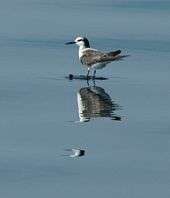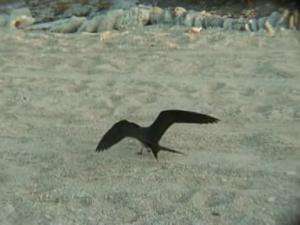Bridled tern
| Bridled tern | |
|---|---|
| | |
| Adult on Lady Elliot Island, Australia | |
| Scientific classification | |
| Kingdom: | Animalia |
| Phylum: | Chordata |
| Class: | Aves |
| Order: | Charadriiformes |
| Family: | Sternidae |
| Genus: | Onychoprion |
| Species: | O. anaethetus |
| Binomial name | |
| Onychoprion anaethetus (Scopoli, 1786) | |
| Synonyms | |
|
Sterna anaethetus Scopoli, 1786 | |
The bridled tern (Onychoprion anaethetus, formerly Sterna anaethetus[2] is a seabird of the tern family Sternidae. It is a bird of the tropical oceans. The scientific name is from Ancient Greek. The genus is onux, "claw", and "prion", nail. The specific anaethetus means "senseless, stupid".[3]
Description

This is a medium-sized tern, at 30–32 cm in length and with a 77–81 cm wingspan similar to the common tern in size, but more heavily built. The wings and deeply forked tail are long, and it has dark grey upperparts and white underparts. The forehead and eyebrows are white, as is a striking collar on the hindneck. It has black legs and bill. Juvenile bridled terns are scaly grey above and pale below.
This species is unlikely to be confused with any tern apart from the similarly dark-backed sooty tern and the spectacled tern from the Tropical Pacific. It is paler-backed than that sooty, (but not as pale as the grey-backed) and has a narrower white forehead and a pale neck collar.
Distribution and movements
This bird is migratory and dispersive, wintering more widely through the tropical oceans. It has markedly marine habits compared to most terns. The Atlantic subspecies melanopterus breeds in Mexico, the Caribbean and west Africa; other races occur around the Arabian Peninsula and in Southeast Asia and Australasia, but the exact number of valid subspecies is disputed. It is a rare vagrant to western Europe. These are the four subspecies listed by the IOC:
- O. a. melanopterus – (Swainson, 1837): Caribbean and West Africa.
- O. a. antarcticus – (Lesson, 1831): Red Sea, Persian Gulf and western Indian Ocean.
- O. a. anaethetus – (Scopoli, 1786): eastern Indian, and Pacific Oceans.
- O. a. nelsoni – (Ridgway, 1919): west coast of Mexico and Central America.
Breeding
This species breeds in colonies on rocky islands. It nests in a ground scrape or hole and lays one egg. It feeds by plunge-diving for fish in marine environments, but will also pick from the surface like the black tern and the gull-billed tern. It usually dives directly, and not from the "stepped-hover" favoured by the Arctic tern. The offering of fish by the male to the female is part of the courtship display.

Various views and plumages
 Bridled tern, at rookery
Bridled tern, at rookery Juvenile on Lady Elliot Island, Queensland, Australia
Juvenile on Lady Elliot Island, Queensland, Australia- In flight Lady Elliot Island, Queensland, Australia
 Juvenile bathing at Perth Zoo
Juvenile bathing at Perth Zoo_Oct_2011_Karnataka_Pelagic_Udupi_flight_scape.jpg)
 ID composite
ID composite
References
- ↑ BirdLife International (2012). "Sterna anaethetus". IUCN Red List of Threatened Species. Version 2013.2. International Union for Conservation of Nature. Retrieved 26 November 2013.
- ↑ Bridge, E. S.; Jones, A. W. & Baker, A. J. (2005). A phylogenetic framework for the terns (Sternini) inferred from mtDNA sequences: implications for taxonomy and plumage evolution Archived July 20, 2006, at the Wayback Machine.. Molecular Phylogenetics and Evolution 35: 459–469.
- ↑ Jobling, James A (2010). The Helm Dictionary of Scientific Bird Names. London: Christopher Helm. pp. 46, 282. ISBN 978-1-4081-2501-4.
External links
| Wikimedia Commons has media related to Onychoprion anaethetus. |
| Wikispecies has information related to: Onychoprion anaethetus |
